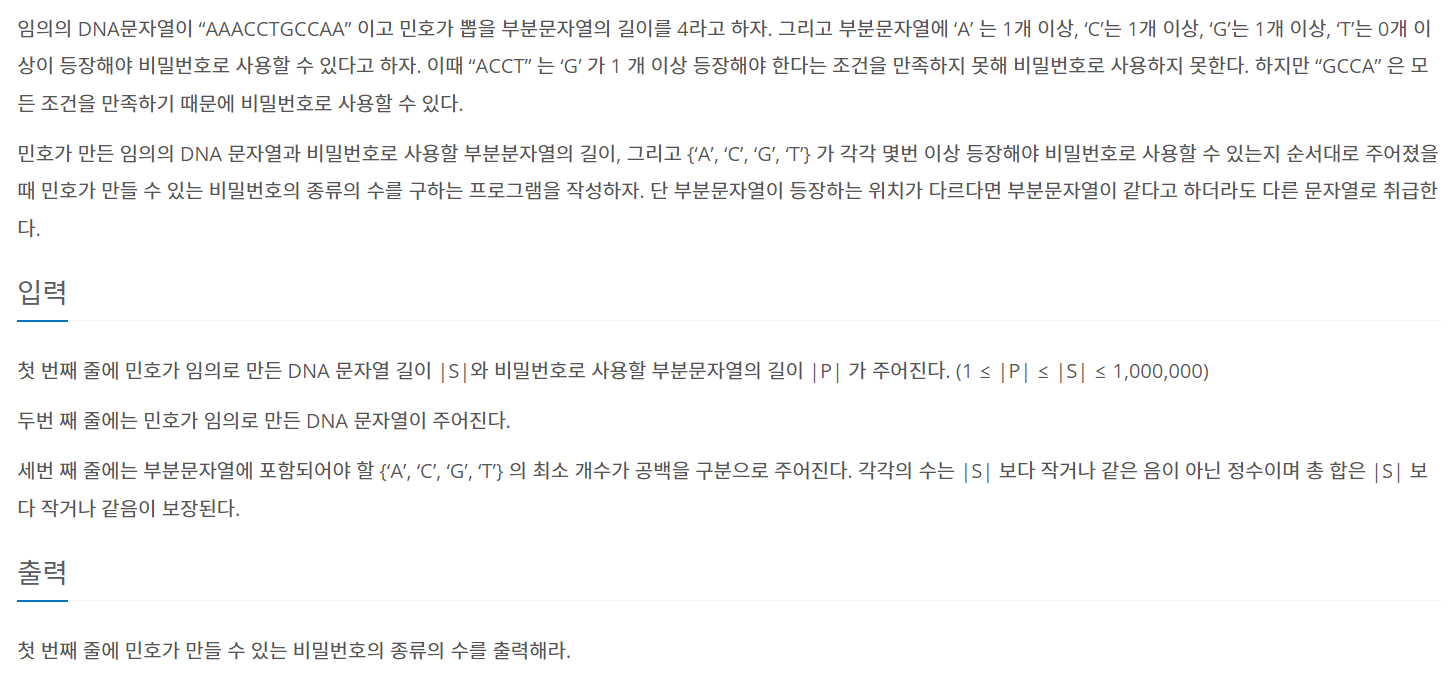Java/코딩테스트
백준 1940, 1253, 12891(JAVA)
Bubbles
2022. 7. 31. 02:41
- start, end 2개의 포인트로 범위 지정해서 범위대로 이동하는 해결법으로 푸는 문제들이다.
- 오름차 순으로 정렬해서 사용하자
📌 백준 1940

📌 투 포인터 이동 원칙
- 찾고자 하는 합이 기준치보다 큰 경우에는 end쪽을 줄이고, 작은 경우에는 start쪽을 올린다(증가) : while문안에서 이 조건을 검사
- 15000이 넘지 않는 재료의 개수, 시간 제한 2초이기에 정렬을 사용할 수 있음
import java.util.*;
import java.io.*;
public class Main {
public static void main(String[] args) throws IOException {
BufferedReader br = new BufferedReader(new InputStreamReader(System.in));
int n = Integer.parseInt(br.readLine());
int m = Integer.parseInt(br.readLine()); // 엔터 기준으로 입력되기 때문에 바로 readLine후 parse
int [] materials = new int[n];
StringTokenizer stringTokenizer = new StringTokenizer(br.readLine());
for (int i = 0; i < n; i++) {
materials[i] = Integer.parseInt(stringTokenizer.nextToken());
}
Arrays.sort(materials); // 배열 정렬
int start = 0;
int end = n-1;
int count = 0;
while (start < end) {
if (materials[start] + materials[end] > m) {
end--;
}
else if (materials[start] + materials[end] < m) {
start++;
}
else {
count++;
start++;
end--;
}
}
System.out.println(count);
}
}
📌 백준 1253

📌 자기 자신이 좋은 수에 포함되면 안 된다. 그래서 start와 end가 각각 i와 같은지 다른지 여부를 판단해야 한다. 이 부분 빼먹어서 실수했다.
📌 start와 end가 만나면 더 이상 수를 찾을 수 없으므로 종료조건을 이걸로 줄 것.
import java.util.*;
import java.io.*;
public class Main {
public static void main(String[] args) {
Scanner sc = new Scanner(System.in);
int num = sc.nextInt();
int count = 0;
long numbers[] = new long[num];
for (int k = 0; k < num; k++) {
numbers[k] = sc.nextLong();
}
Arrays.sort(numbers);
for (int i = 0; i < num; i++) {
int start = 0;
int end = num-1;
while (start < end) {
if (numbers[start] + numbers[end] == numbers[i]) {
if (start != i && end != i) {
count++;
break;
}
else if (start == i) {
start++;
}
else if (end == i) {
end--;
}
}
else if(numbers[start] + numbers[end] > numbers[i]) {
end--;
}
else {
start++;
}
}
}
System.out.println(count);
}
}
📌 백준 12891

<tmi>
너무 복잡해서 (?) 코드 한줄한줄에 썼다. 실버2도 힘든 코딩 실력.................................
풀다가 막혀서 책 해설을 좀 찾아봤는데, removeChar함수 부분에서 stateArray와 checkArray 같은지 판별 후 checkCondition을 먼저 감소시켰어야 했는데 순서를 뒤집어서 틀렸었다. 답이 어쩐지 계속 안 나왔었다...^_^
import java.util.*;
import java.io.*;
public class Main {
static int checkArray[];
static int stateArray[]; // ACGT 순서
static int checkCondition;
public static void main(String[] args) throws IOException {
BufferedReader reader = new BufferedReader(new InputStreamReader(System.in));
StringTokenizer stringTokenizer= new StringTokenizer(reader.readLine());
int wholeLen = Integer.parseInt(stringTokenizer.nextToken()); // 전체 문자열 길이
int partLen = Integer.parseInt(stringTokenizer.nextToken()); // 부분 문자열 길이
int result = 0;
checkCondition = 0;
char charArray[] = new char[wholeLen]; // 전체 문자열 입력받을 배열
charArray = reader.readLine().toCharArray();
checkArray = new int[4]; // ACGT 각각 몇개 들어있어야 하는지 조건 저장 위한 배열
stateArray = new int[4]; // 지금 읽은 부분 문자열에 ACGT 몇개씩 들어있는지 상태 저장하기 위한 배열
stringTokenizer = new StringTokenizer(reader.readLine());
for (int i = 0; i < 4; i++) {
checkArray[i] = Integer.parseInt(stringTokenizer.nextToken());
if (checkArray[i] == 0) {
checkCondition++; // 만약 한 글자 아예 없어도 된다! 이 경우라면 condition 증가
}
}
for (int j = 0; j < partLen; j++) {
readChar(charArray[j]); // 맨 처음 초기 partLen 만큼 먼저 읽어주고, 그 다음 한 칸씩 이동.
}
if (checkCondition == 4) {
result++; // 처음 partLen만큼 읽었는데 만족한다면 일단 result 증가.
}
for (int i = partLen; i < wholeLen; i++) {
int start = i - partLen; // 시작 부분, 이동하면서 맨 앞은 버리기 때문에 얘는 제거가 필요;
readChar(charArray[i]); // partLen위치부터 한 칸씩 이동하면서 읽음, 이 반복문에서 i가 마지막 인덱스
removeChar(charArray[start]);
if (checkCondition == 4) {
result++; // 한 칸 이동할 때마다 checkCondition 만족하나 안하나 검사
}
}
System.out.println(result);
reader.close();
}
public static void readChar(char element) {
switch(element) {
case 'A' :
stateArray[0]++;
if (stateArray[0] == checkArray[0]) {
checkCondition++;
}
break;
case 'C' :
stateArray[1]++;
if (stateArray[1] == checkArray[1]) {
checkCondition++;
}
break;
case 'G' :
stateArray[2]++;
if (stateArray[2] == checkArray[2]) {
checkCondition++;
}
break;
case 'T' :
stateArray[3]++;
if (stateArray[3] == checkArray[3]) {
checkCondition++;
}
break;
}
}
public static void removeChar(char element) {
switch(element) {
case 'A' :
if (stateArray[0] == checkArray[0]) {
checkCondition--; // 현재까지의 상태가 문제 조건을 담은 배열과같을 경우에만 먼저 check조건 감소(읽으면서 증가시켰던것)
}
stateArray[0]--; // 그러고 나서 state 감소해야함..! 먼저 state감소시키면 정확하게 checkCondition 조정불가.
break;
case 'C' :
if (stateArray[1] == checkArray[1]) {
checkCondition--;
}
stateArray[1]--;
break;
case 'G' :
if (stateArray[2] == checkArray[2]) {
checkCondition--;
}
stateArray[2]--;
break;
case 'T' :
if (stateArray[3] == checkArray[3]) {
checkCondition--;
}
stateArray[3]--;
break;
}
}
}